Mil Mi-17 Video - Flying sideways
|
|
Mil Mi-17
Mi-17 / Mi-8M
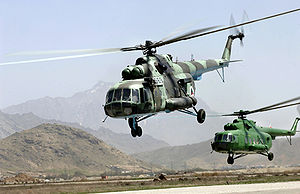
Picture - Afghan Mil-Mi-17s
Role: Transport helicopter
Manufacturer: Mil Moscow Helicopter Plant
Kazan Helicopter Plant
First flight: 1970s
Introduced: 1970s
Status: In service
Primary users: Russia
ca. 60 other countries
Produced: about 12,000
Developed from: Mil Mi-8
The Mil Mi-17 (also known as the Mi-8M series in Russian service, NATO reporting name "Hip") is a Russian-designed helicopter currently in production at two factories in Kazan and Ulan-Ude. Mil Mi-8/17 is a medium twin-turbine transport helicopter that can also act as a gunship. The Soviet Union specifically designed the Mi-17 for the Soviet war in Afghanistan.
Development
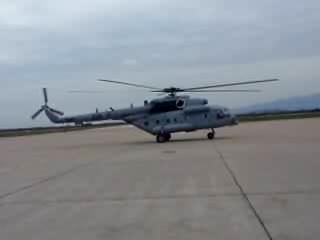
Picture - Croatian Mil Mi-17
Developed from the basic Mi-8 airframe, the Mi-17 was fitted with the larger TV3-117MT engines, rotors, and transmission developed for the Mi-14, along with fuselage improvements for heavier loads. Optional engines for 'hot and high' conditions are the 1545 kW (2070 shp) Isotov TV3-117VM. Recent exports to China and Venezuela for use in high mountains have the new VK-2500 version of the engine with FADEC control.
The designation Mi-17 is for export; Russian armed forces call it Mi-8MT. The Mi-17 can be recognized because it has the tail rotor on the port side instead of the starboard side, and dust shields in front of the engine intakes. Engine cowls are shorter than on the TV2 powered Mi-8, not extending as far over the cockpit, and an opening for bleed-valve outlet is present forward of the exhaust.
Actual model numbers vary by builder, engine type, and other options. As an example, the sixteen new Ulan Ude built machines delivered to the Czech Air Force in 2005 with -VM model engines were designated as Mi-171Sh, a development of the Mi-8AMTSh. Modifications include a new large door on the right side, improved Czech-built APU, Kevlar armor plates around the cockpit area and engines. Eight have a loading ramp in place of the usual clamshell doors, and will load a vehicle up to the size of an SUV.

Picture - Two Egyptian Mi-17 helicopters after unloading troops during an exercise.
In October 2007 defense-aerospace.com reported the government of Saudi Arabia had signed a contract for up to 150 Mi-35 and Mi-17 helicopters worth $2.2billion.
In May 2008 licensed production of the Mi-17 started in China, with production being led by Mil Moscow Helicopter Plant JSC and the Sichuan Lantian Helicopter Company Limited in Chengdu, Sichuan province. The plant built 20 helicopters in 2008, using Russian Ulan-Ude-supplied kits; production is expected to reach 80 helicopters per year eventually. The variants to be built by Lantian will include Mi-171, Mi-17V5, and Mi-17V7.
Operational history
Service usage
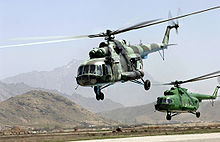
Picture - Afghan National Air Corps Mi-17s take off in a formation.
The Mi-17 was used extensively by the Sri Lanka Air Force in the Sri Lankan Civil War. Seven of them were lost in combat and attacks on airports.
The Mi-17 was used by the Colombian Army in Operation Jaque.
In 2001, the Macedonian Air Force used the Mi-17 against Albanian insurgents.
The Mi-17 is also used by search and rescue teams such as the Malaysian Fire and Rescue Department.
Executive Outcomes used them extensively in its operations in the Angolan Civil War.
The Mexican Navy utilizes their Mi-17s for anti-narcotic operations such as locating marijuana fields and dispatching marines to eradicate the plantations.
The Slovakian forces operate Mi-17s in Kosovo as part of KFOR.
Recent orders
On 28 October 2008 the Royal Thai Army announced a deal to buy 6 Mi-17s to meet its requirement for a medium-lift helicopter. This is the first time the Thai military has acquired Russian aircraft instead of American. Flight International quotes the Thai armyā€™s rationale: "We are buying three Mi-17 helicopters for the price of one Black Hawk. The Mi-17 can also carry more than 30 troops, while the Black Hawk could carry only 13 soldiers. These were the key factors behind the decision."
On 15 December 2008, it was reported that India would purchase 80 Mi-17IV helicopters, which would be delivered to the Indian Air Force between 2010 and 2014 to replace aging Mi-8s. An order for a further 59 was placed in August 2010.
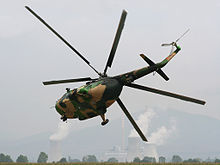
Picture - Macedonian Air Force Mi-17 performing a very tight low-level right turn. The power plant REK Bitola can be seen in the background.
On 11 June 2009, it was announced that the United States had handed over four Mi-17 cargo helicopters to the Pakistan Army to facilitate its counter-terrorism operation. (Note - A leaked US embassy cable published on Wikileaks describes the request made by Pakistan Chief of Army Staff General Kayani for additional helicopters
On 10 July 2009, it was announced that Chile would pursue talks with Russia to purchase five Mi-17 multi-role helicopters for the Chilean Air Force, despite pressure from the United States.
On 16 September 2009, US Navy's Navair delivered the last two of four Mi-17s to the Afghan National Army Air Corps. On 19 June 2010, it was announced that the US government would buy and refurbish 31 Mi-17 helicopters from Russia to supply the Afghan Army.
The US is reportedly considering adding the helicopter to the US military for Special Forces use in order to obscure troop movements. The US uses some Mi-8s and Mi-17s for training, and has purchased units for allies in Iraq, Afghanistan and Pakistan.
In August 2010 a contract was signed by the Argentine Air Force for two Mi-17Es, plus an option on a further three, to support Antarctic bases.
In September 2010, the Polish Defense Minister announced that his country would buy 5 brand new Mi-17 from Russia, to support Polish operations in Afghanistan.
In 2010, the Kenya Air Force purchased 3 Mi-171 Hips as medium-lift helicopters to supplement its aging fleet of IAR 300 PUMAS which had been flying for more than 20yrs.
Variants
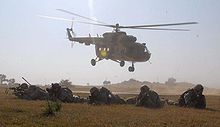
Picture - US Army's 14th Cavalry Regiment soldiers prepare to rendezvous with Indian Army troops after exiting an Mi-17 helicopter flown by the 107th Indian Army Aviation Helicopter Unit.
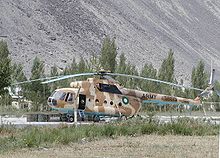
Picture - Pakistan Army Mi-17
Mi-8AMT
Slightly modified version of Kazan's Mi-8MTV, built in Ulan-Ude from 1991 and still powered by TV3-117VM engines although nowadays VK-2500 engines are optional. Also known as Mi-171.
Mi-8AMTSh
Armed assault version of the Mi-8AMT, can carry the same range of weapons as the Mi-24 including the "Shturm" ATGM. Fitted with a new large door on the right side (except the prototype), kevlar plates around the cockpit area and engines, and sometimes a loading ramp in place of the usual clamshell doors. Czech Republic and Croatia have ordered these types in 2005 and 2007. Bangladesh Air Force also operates Mi-171Sh as armed helicopter
Mi-8MT
Basic updated version of the Mi-8T, powered by two 1,397 kW (1,874 hp) Klimov TV3-117MT turboshaft engines. Provision for twin or triple external stores racks. The export version is known as Mi-17.
Mi-8MTV
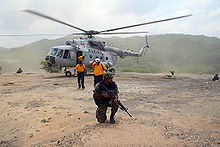
Picture - Mexican Navy Mi-17 with RDR-1500B Radar and FLIR Star SAFIRE II
Hot and High version, powered by two Klimov TV3-117VM high-altitude turboshaft engines. This type has a maximum ceiling of 6,000 m.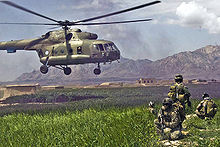
Picture - Mi-17 in Gulistan district, Farah province, Afghanistan
Mi-8MTV-5
Picture - Kazakhstan Air Force Mil Mi-8MT
Smoke-screen laying version.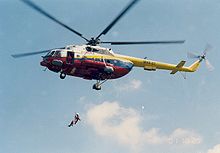
Picture - Malaysian Fire and Rescue Department Mi-17-1V
Mi-8MTS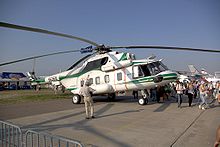
Picture - Mi-17V-5
Electronic jamming version of the Mi-8MT.Mi-17 (NATO - Hip-H)
Improved version of the Mi-8, powered by two Klimov TV3-117MT turboshaft engines. Basic production version.
Mi-17-1M
High altitude operations version, powered by two Klimov TV3-117VM turboshaft engines.
Mi-17-1V
Military transport, helicopter gunship version, powered by two Klimov TV3-117VM turboshaft engines. Export version of the Mi-8MTV-1.
Mi-17-1VA
Flying hospital version.
Mi-17V-3
Export version of the Mi-8MTV-3.
Mi-17V-5
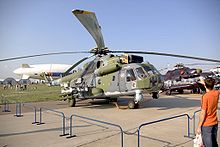
Picture - Mi-171Sh
Export version of the Mi-8MTV-5. In Canadian Forces service, the Mi-17-V5 is designated CH-178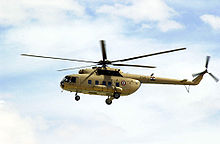
Picture - Egyptian Air Force Mi-17 flies over Range A as the Combined Live fire Exercise (CALFEX) is conducted near Mubarak
Export version of the Mi-8MTPB.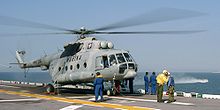
Picture - A Mexican Navy Mi-17 helicopter stands by for passengers on the flight deck aboard the amphibious assault ship USS Bataan (LHD 5), off the coast of Mississippi.
Mi-172Accidents and notable incidents
In late July 2005, Garang died after the Ugandan presidential Mi-172 helicopter he was flying in crashed. He had been returning from a meeting in Rwakitura with long-time ally President Yoweri Museveni of Uganda.
On 31 May 2008 a People's Liberation Army Mi-171 transport crashed in southwest Sichuan provinces with 14 onboard. It was operating mission during 2008 Sichuan earthquake.
On 19 November 2010 an Indian Air Force Mi-17 helicopter crashed near Tawang in Arunachal Pradesh, killing all 12 people on board. It had taken off from Tawang for Guwahati, and crashed about five minutes later at Bomdir. Though not confirmed, the reason is believed to be pilot error, in that, the pilots took off in less than 50 meters visibility.
Specifications (Mil-17-1V)
Data from Jane's All The World's Aircraft 2003-2004
General characteristics
Crew: Three - two pilots and one engineer
Capacity: 30 troops or 12 stretchers or 4,000 kg (8,820 lb) cargo internally /5,000 kg (11,023 lb) externally slung.
Length: 18.465 m (60 ft 7 in)
Rotor diameter: 21.25 m (69 ft 10½ in)
Height: 4.76 m (15 ft 7¼ in)
Disc area: 356 m² (3,834 ft²)
Empty weight: 7,489 kg (16,510 lb)
Loaded weight: 11,100 kg (24,470 lb)
Max takeoff weight: 13,000 kg (28,660 lb)
Powerplant: 2x— Klimov TV3-117VM turboshafts, 1,633 kW (2,190 shp) each
Performance
Maximum speed: 250 km/h (135 knots, 155 mph)
Range: 465 km (251 nmi, 289 mi) (standard fuel)
Service ceiling: 6,000 m (19,690 ft)
Rate of climb: 8 m/s (1,575 ft/min)
Armament
up to 1,500 kg (3,300 lb) of disposable stores on six hardpoints, including bombs, rockets, and gunpods.
Related development
Mil Mi-8
Mil Mi-14
Mil Mi-38
Comparable aircraft
Aérospatiale Super Frelon
Eurocopter AS332
AgustaWestland AW101
NHIndustries NH90
Sikorsky UH-60 Black Hawk
The initial version of this article was based on material from aviation.ru. It has been released under the GFDL by the copyright holder.
Jackson, Paul (2003). Jane's All The World's Aircraft 2003-2004. Coulsdon, UK: Jane's Information Group. ISBN 0-7106-2537-5.
Mil Mi-17 Pictures
Living Warbirds: The best warbirds DVD series.
Source: WikiPedia